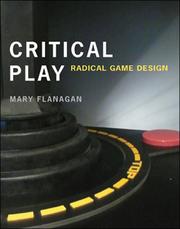Critical Play - Radical Game Design by Mary Flanagan - ISBN 0262062682 - The MIT Press 2009
Motivation
Mentioned at ~min40 during Q&A of Cyborg Anthropology: A Short Introduction and discussed about games, simulation and reality for brains in development physiologically and cognitively with Claude the day before.
Pre-reading model
Draw a schema (using PmGraphViz or another solution) of the situation of the area in the studied domain before having read the book.
Reading
- 1 Introduction to Critical Play
- "Games ultimately create cognitive and epistemological environments that position the player or participant with the experiences previously described in meaningful ways." (p6)
- mention of Clayton Christensen (p12)
- activitist games, cf Serious Games: Videogames for Changing the World and Lifelong Learning by Christopher Harz during HplusSummitHarvard
- 2 Playing House
- 3 Board Games
- 4 Language Games
- 5 Performative Games and Objects
- mention of Ghost in the Shell film series and Paprika (p169)
- Anne-Marie Schleiner
- mention Michel de Certeau (p182), suggested read by Martin
- 6 Artists' Locative Games
- 7 Critical Computer Games
- mention of Wittgenstein (cf Logicomix) and Kuhn (p235)
- Oil God, Persuasive Games
- "Games are frameworks that designers can use to model the complexity of the problems that face the world and make them easier for the players to comprehend." (p249)
- 8 Designing for Critical Play
- mention of Jacques Ranciere (p260)
- "Above all, a game is an opportunity, an easy- to-understand instrument by which context is defamiliarized just enough to allow what Huizinga famously refers to as his <<a magic circle>> of play to occur." (p262)
See also
- Seedea:Research/Drive

- Seedea:Research/StrategicalEpistemology

- Art
- own projects
- Cognition#GoalFocusAttention
- Wikipedia:Brian Sutton-Smith

- 5 Creepy Ways Video Games Are Trying to Get You Addicted by David Wong, Cracked.com March 2010
- Critical Play by Mary Flanagan, TEDxDartmouth April 2010
- Strong National Museum of Play
- The American Journal of Play University of Illinois Press
- The Association for the Study of Play (TASP) dedicated to interdisciplinary research and theory construction concerning play throughout the world.
- add ref#99 to my aphorism on philosophy as an action verb
- Omnsh.org : l'Observatoire des Mondes Numériques en Sciences Humaines with plenty of links on games
- SCVNGR "Go places. Do challenges. Earn points and unlock rewards!"
- Jane McGonigal: Gaming Can Make a Better World by Jo-Anne Green, Networked_Performance April 2010
- Games for social change by Mary Flanagan, SXSWi 2008
- tiltfactor lab by Mary Flanagan
- mission is to research and develop software, events, experiences, and artifacts that create rewarding, compelling interactions.
- MaryFlanagan.com
- Values at Play (VAP)
- research project assists and encourages designers to create computer games that identify and promote human values.
- Wikipedia:Gamification

- Fun is the Future: Mastering Gamification by Gabe Zichermann, Google Tech Talk October 2010
- Meaningful Play: Getting Gamification Right by Sebastian Deterding, Google Tech Talk January 2011
- Wikipedia:Game studies

- Wikipedia:History of games

Overall remarks and questions
- based on the example mentioned in Cyborg Anthropology: A Short Introduction I was expecting a conceptual framework, a mapping between games and physiological or social basis yet I did not find it in the book.
- content was more oriented toward what games could be good for and a bit about the role of few during history
Synthesis
So in the end, it was about X and was based on Y.
Critics
Point A, B and C are debatable because of e, f and j.
Vocabulary
(:new_vocabulary_start:)
new_word
(:new_vocabulary_end:)
Post-reading model
Draw a schema (using PmGraphViz or another solution) of the situation of the area in the studied domain after having read the book. Link it to the pre-reading model and align the two to help easy comparison.
Categories
Back to the Menu
 Fabien Benetou's PIM
Fabien Benetou's PIM






